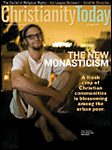the "new monasticism"
 Last week I noticed Christianity Today in the magazine rack in the library, with a familiar face on the cover (Shane Claiborne from the simple way). So I read the article. It was very favorable, talking not just about the simple way and Camden house (who were both at the camp meeting last month), but also Rutba house, and even mentioning Reba Place Fellowship.
Last week I noticed Christianity Today in the magazine rack in the library, with a familiar face on the cover (Shane Claiborne from the simple way). So I read the article. It was very favorable, talking not just about the simple way and Camden house (who were both at the camp meeting last month), but also Rutba house, and even mentioning Reba Place Fellowship.
It was so favorable, actually, that I wondered. How do these radical groups come off sounding so good in this mainstream Christian magazine?
The beginning of the monastic movement (i.e. the desert fathers) was very critical of society, including its religion, and their complete withdrawal was a strong statement of that critique. Other monastic "revolutions" (the Trappists breaking away from the Cistercians, which broke away from the Benedictines, for instance) were also a reaction against what they saw as the dilution and laxness of discipleship in their religious orders. So there was definitely criticism of mainstream religion there.
But in every case, the movement is eventually assimilated and given a place and role in the social and religious structure of the time. Its critique is quieted and the tension relaxes. So "monasticism" loses its radical challenge.
I assume the new monasticism also springs out of a strong critique of society and the church, and that their different way of living and serving others is meant as a prophetic challenge to the church. I guess I see signs of that in the article's complaint about "shaming messages" (to other Christians):
In intentional community movements, one sometimes senses an element of guilt that is used to manipulate suburban youths into giving their lives to work with the poor. “And the flip side of that [guilt] tends to be self-righteousness projected on everyone else,” says Jenell Williams Paris, who lived in community during college and graduate school from 1991 to 1999 and now teaches anthropology at Bethel University in Minnesota. “When I went to Philadelphia, I heard people like Tony Campolo, Ron Sider, Jim Wallis, give these, what they called, prophetic messages, and what I now understand as a lot of shaming messages to white, middle-class evangelicals.”But I didn't hear those messages in the article, except perhaps vaguely. I'm not sure why that is (edited out, maybe?). But shouldn't the prophetic challenge be there?
This part of the article pretty well describes the prophetic role (my italics):
A group of "monks" could help American Christians better stand against the pervasive consumerism and individualism of pop culture by providing an ideal of unworldly living. As CT wrote in 1988, such a remonasticization "would look to the biblical antecedents for a select group of holy persons set apart to call all persons to holiness, such as the Old Testament Nazirites … and Jesus' calling of disciples to train and teach with the goal of drawing all Israel to the same discipleship."But why does this sound so acceptable? Where is the opposition to the prophet?
Maybe it's because it's not clear that they are calling all Christians to the same "ideal" discipleship. Isn't that what is usually offensive? Jesus said, "For I tell you, unless your righteousness exceeds that of the scribes and Pharisees [the standards of religious morality of the time], you will never enter the kingdom of heaven." (Mt 5.20) And he preached "Woe to you!" and "Hypocrites!" He was clear that the discipleship of the majority (even of the most respected religious leaders) was not good enough. So they hated him and saw him as threatening to the religious and social structure. But isn't that how people always reacted to the prophets?
And isn't that how people should see us as well? "Remember the word that I said to you, 'A servant is not greater than his master.' If they persecuted me, they will persecute you... They will put you out of the synagogues..." (Jn 15.20, 16.2)


 subscribe
subscribe